Want to bring your kitty on your next flight? Here's what you should know about how to fly with a cat before booking a ticket.
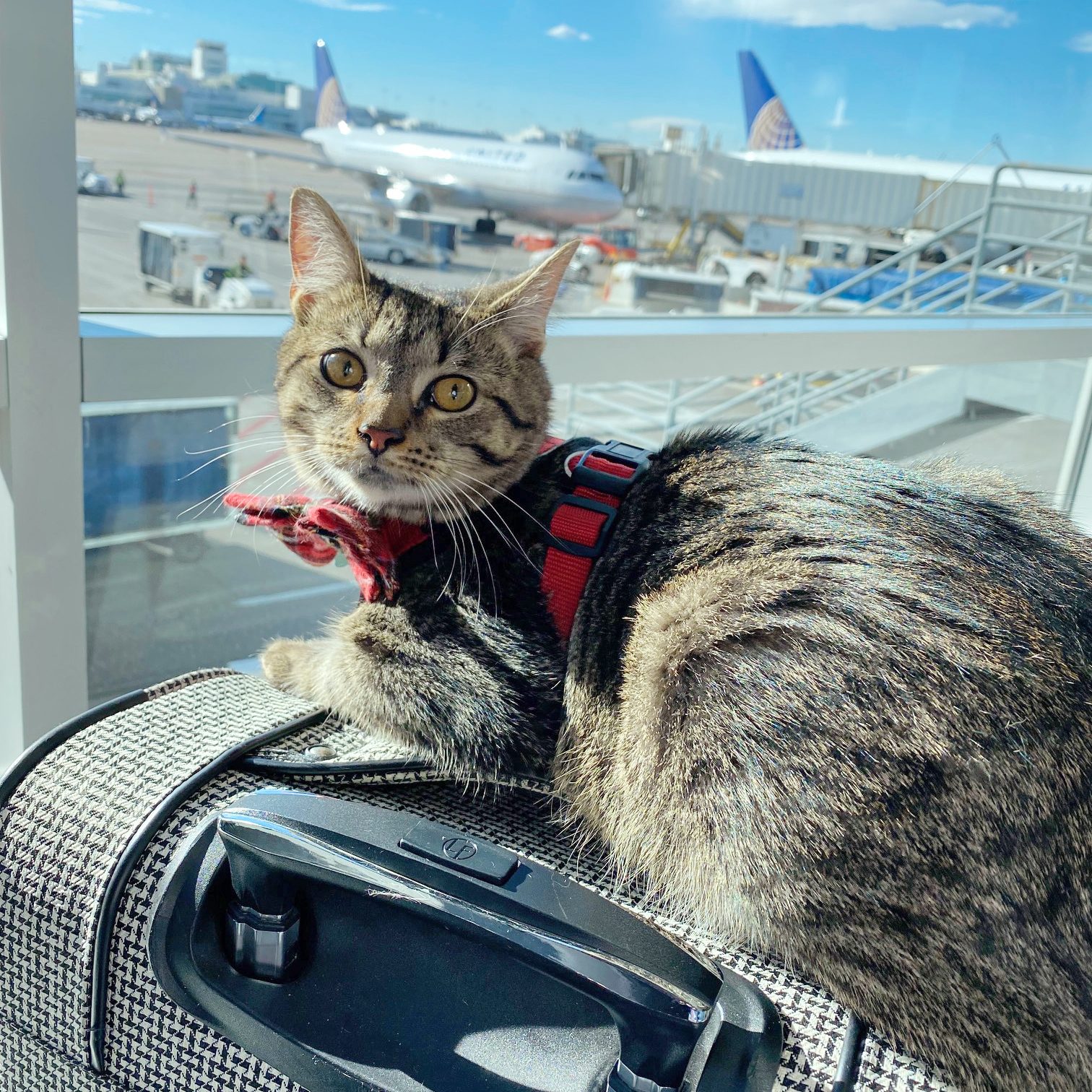
How to Fly with a Cat: 19 Tips from Animal and Travel Experts

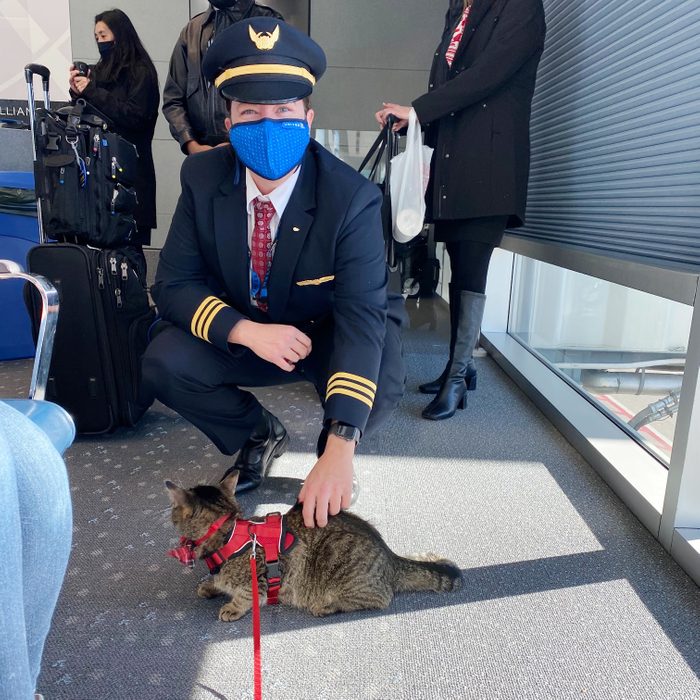
Is it safe for cats to fly on airplanes?
Overall, it is safe for cats to fly on an airplane. However, if your cat is one of the short-headed brachycephalic cat breeds, which are prone to respiratory problems, adding the stress and anxiety of air travel can make breathing even more difficult. Visit your vet a few weeks before traveling to make sure your cat is medically cleared to fly.
Additionally, pressure changes can hurt cats’ ears, similar to how your own ears might pop, Dr. Smith says. Because of this, he recommends that your cat travel with you in the cabin, rather than in the cargo hold. According to Melissa Magnuson, DVM, a veterinarian at Canobie Lake Veterinary Hospital in Windham, New Hampshire, offering small sips of water or small treats can help. “[But] I wouldn’t offer more than four to five treats or four to five sips of water for every four-hour flight, so as not to make your cat nauseous,” she cautions. That said, don’t be surprised if your kitty turns up its nose at food or water: It’s a perfectly normal behavior for cats in strange settings. They should return to their normal eating habits within 24 hours of arriving at your destination, Dr. Magnuson says.
Other reasons not to send your cat to the cargo hold: Although these areas are pressurized, the temperatures can vary and become uncomfortable for your pet. Plus, animals that fly in the live cargo hold need to be checked in hours before the flight and later transferred from the staging area to the plane, which could be long and very stressful for your cat. When your cat flies with you in the cabin, you have easy access to monitor and comfort them right at your feet.
Medical clearance aside, is it cruel to take a cat on a plane? After all, flying is very different from a short car ride to the vet. It’s louder and disrupts an animal’s routine for a more extended period. Yet with early and careful preparations, and a bit of learning how to train a cat to travel, your kitty can become a more mellow feline flier.
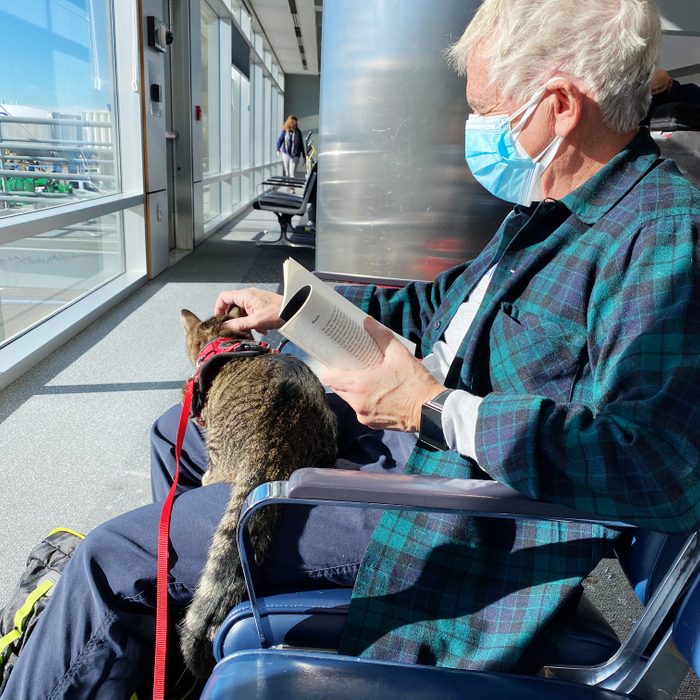
How much does it cost to bring a cat on a plane?
Even though your little feline doesn’t take up much space stowed under the seat, flying with a cat isn’t free, and fees vary depending on the airline. Plus, the Federal Aviation Administration (FAA) now treats emotional support animals (ESAs) like regular pets. So whether your cat is a bona fide ESA or simply a furry sidekick, you’ll have to pay standard pet fees, which are the same whether you’re flying with dogs or cats.
Be sure to check with your airline if the fee is refundable should you change plans. Which airlines are best to fly with a cat? Here’s a breakdown of costs, drawbacks and perks for five of the top airlines:
| Airline | Cost | Extras |
| American Airlines | $150 each way | If your itinerary includes a voluntary stopover/connection of more than four hours, fees apply for each connection segment. |
| Delta Airlines | $95 each way | A female cat can travel with her unweaned litter in the same carrier as long as the kittens are between 8 weeks and 6 months of age and can all fit comfortably in the carrier. |
| JetBlue | $125 each way | Purchase an Even More Space seat for up to 7 inches more legroom for your carrier, early boarding and access to overhead bins, as well as an expedited security lane (in select airports). |
| Southwest Airlines | $125 each way | Pet fare is refundable if you cancel your reservation or if your flight is canceled. |
| United Airlines | $150 each way | You’ll need to pay an additional $125 for each stopover of more than four hours within the U.S. |
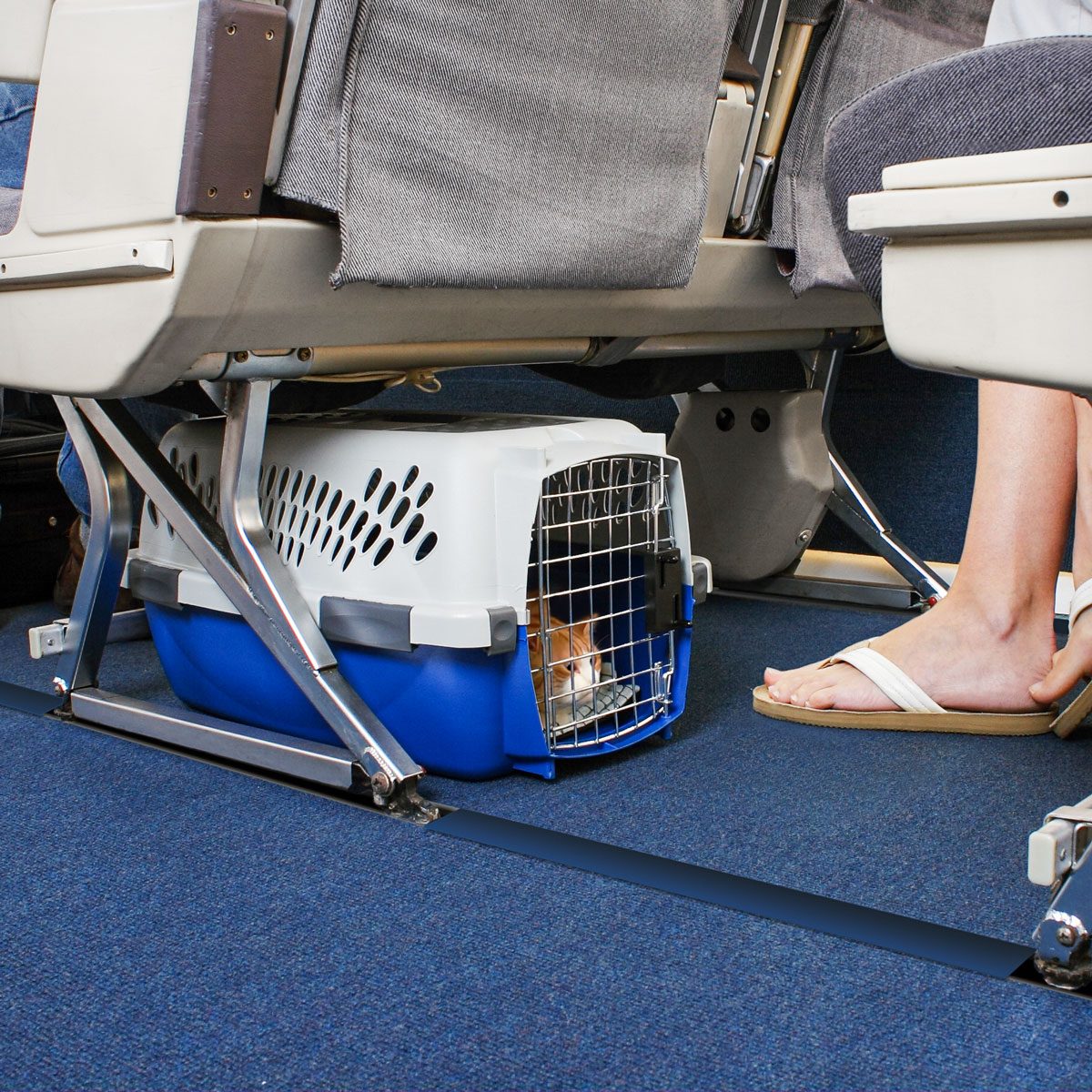
What are the cat carrier size policies for major airlines?
Pet carrier size requirements vary by airline, but the general rule of thumb is that they must be small enough to fit under a standard airplane seat. Just keep in mind that the space can vary slightly between different planes. Make sure to double-check your airline’s pet carrier dimensions before you fly, so you and your cat can travel comfortably and safely.
American Airlines: American Airlines allows soft-sided and hard-sided carriers, although they recommend soft. Soft-sided carriers can be up to 18 inches long by 11 inches wide and 11 inches high, while hard-sided carriers can be 19 inches long by 13 inches wide and 9 inches high for mainline American flights. Regional fights on American Eagle have their own hard-sided carrier guidelines: They must be 16 inches long by 12 inches wide and 8 inches high. You may also bring one personal item, such as a handbag or carry-on luggage that fits in the overhead bin, in addition to the cat carrier.
Delta Airlines: Cats are stowed under the seat, but the specific dimensions of the carrier may vary depending on the aircraft, so it’s essential to check the Delta website for the exact measurements. Delta’s general rule of thumb is to use a carrier 18 inches long by 11 inches wide and 11 inches high. Additionally, carriers need to be leakproof and have ventilation on three sides for domestic travel, and four sides for international. Cats must be at least 8 weeks old to travel. Delta allows two cats of the same size to travel in one kennel as long as they can both fit comfortably, and bonus—you’ll only be charged for one cat.
JetBlue: Your pet and approved pet carrier count as one personal item and must fit under the seat in front of you. Two cats per person are allowed, but each cat must have its own carrier, and you’ll need to pay for a second seat and pet fee for the second kitty. Pet carriers can be purchased on the JetBlue website, or you can use your own. However, they must be no larger than 17 inches long by 12.5 inches wide and 8.5 inches high.
You have the option to purchase an additional seat for your pet, but the carrier must remain stowed under the seat during taxi, takeoff and landing. Once the flight is in the air, you can place the carrier on the empty seat next to you, but you can’t take the cat out of the carrier.
Southwest Airlines: Your pet carrier must be able to fit under the seat in front of you, and your cat must be able to stand up and move around in the carrier easily. Pet carriers can be soft- or hard-sided, but they must be leakproof and well-ventilated. Carriers up to 18.5 inches long by 13.5 inches wide and 8.5 inches high are accepted. A pet carrier is considered either a personal item or a carry-on.
United Airlines: United accepts approved hard- or soft-sided carriers. Hard-sided carriers must be no more than 17.5 inches long by 12 inches wide and 9 inches tall; soft-sided carriers need to measure no more than 18 inches long by 11 inches wide and 11 inches tall. If you have two cats, you must buy two seats, and the second seat must be next to your assigned seat so you can care for both of your feline fliers. Note: Some planes have limited space under the middle seat, which allows for only one pet per person on the airplane.
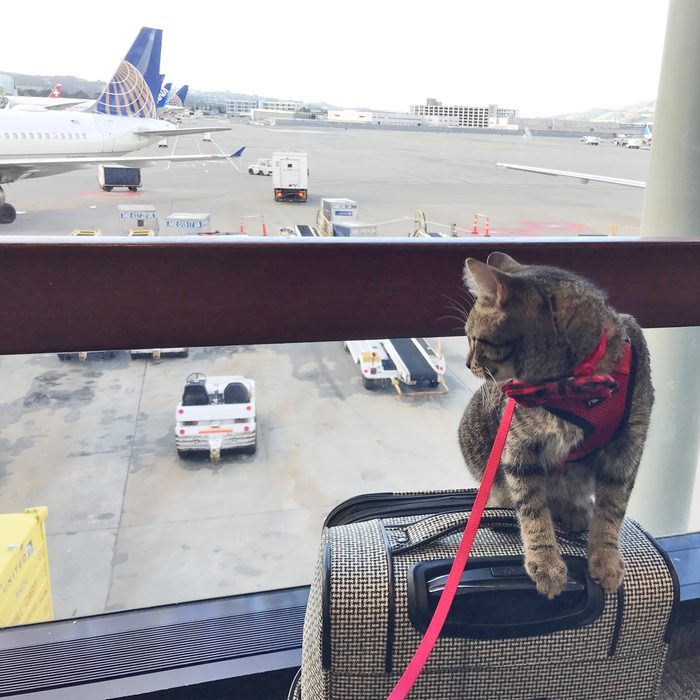
What steps should you take before you book a flight?
1. Check on airline policies
You’ll need to do a bit of research to figure out which airlines are best to fly with your cat in a pet carrier. Airlines offer a limited number of pet reservations for the cabin, so book early. Pet policies, such as carrier size, cat age and breed requirements, vary depending on the airline. Plus, some airlines don’t accept brachycephalic cat breeds. To choose the best airline for you and your kitty, visit the pet policy section of the airline website.
2. Talk to your vet
If your cat hasn’t visited the vet in a while, getting a checkup is essential to ensure it’s safe for your cat to fly, especially if they have been showing signs they might be sick. “Like humans, certain medical conditions could be more concerning, but your vet will know if those are a factor for your cat, and what can be done for their benefit,” says Dr. Smith. This is also a good time to ask about ways to calm your cat’s anxiety. Your vet may prescribe anti-anxiety medication or pheromones to help calm your cat’s frazzled nerves while traveling.
3. Request medical records
Ask your vet what specific health documents you’ll need for your destination. “Flying domestically within the U.S. requires a health certificate from a small-animal veterinarian. Flying overseas or from the [mainland] U.S. to Hawaii, Alaska or Puerto Rico is considered international, and you will need an international USDA health certificate,” says Dr. Magnuson. Get a printout and/or digital records with updated health certificates and proof of vaccines to keep handy for travel days.
4. Buy the right size pet carrier
Your current cat carrier may be perfectly suitable for your needs, but you should measure the dimensions to ensure they meet the airline requirements, which can vary even within the airline. For instance, on American, a mainline flight specifies the carrier be 19 inches high by 13 inches wide and 9 tall; yet carriers must be 16 inches wide by 12 inches wide and 8 inches tall for regional flights on its American Eagle jets. JetBlue and Southwest sell approved carriers on their respective websites if you want to be certain the size has been approved.
5. Help your cat get comfy with its carrier
If your cat’s only experience with cat carriers was a horrific stress-fest when you took a trip to the vet, it’s prudent to gently get your cat more comfortable in it long before your flight. Your kitty should feel like the carrier is a cozy and safe hangout. “I leave a cat carrier out in my home 24/7 so it’s part of the cats’ environment, versus something that only comes out for ‘scary’ reasons,” says Samantha Bell, a cat expert for Best Friends Animal Society. Once your cat is comfortable getting in the carrier, try closing the carrier door for a few seconds and rewarding them, working up to more time in the closed carrier.
6. Train your cat to wear a harness
Cats can slip out of a collar, and attaching a leash to a collar could hurt their throat when they pull. A harness is a better option to keep your kitty safe and comfortable while walking. Fair warning: Your cat will probably hate it at first, which you’ll no doubt be able to tell by your cat’s body language. They might run off and hide, or refuse to move while the harness is on.
That was the experience for Elainna Coelho, who frequently flies with her cat, D’Artagnan. (That’s D’Artagnan featured in all the photos in this article.) “The first month of harness training, I was gently pulling him around and bribing him with treats,” says Coelho. With consistent training, he eventually got used to his harness ahead of the flight and now enjoys exploring while at home or at an airport terminal.
7. Introduce the concept of traveling
Long before flying with a cat, it’s wise to expose your feline to the various elements it will experience while traveling. “I think this is so important, because if you don’t slowly introduce other people, noises and smells, it will be very overwhelming for the cat, especially if they are timid,” Coelho says. Start with short car trips and work your way up to longer trips. Add stops at the park, a pet store and a friend’s house.
8. Ensure your cat has a permanent ID
Since your cat isn’t flying in the cargo area, you’re not likely to lose your cat while it’s secured in their carrier by your feet. Still, it’s best to verify the details of your pet’s identification, whether it’s an ID tag, microchip or GPS tracking device, just in case your cat goes missing while at the airport or during your stay.
9. Adjust your cat’s feeding schedule
If you’re worried about your cat’s feeding schedule getting disrupted while traveling, you can start adjusting it to match the flight day about a week ahead of time, Bell advises. “In my experience flying with cats, they weren’t hungry during the flights, so don’t be alarmed if your cat waits to eat hours after they’ve landed,” she says.
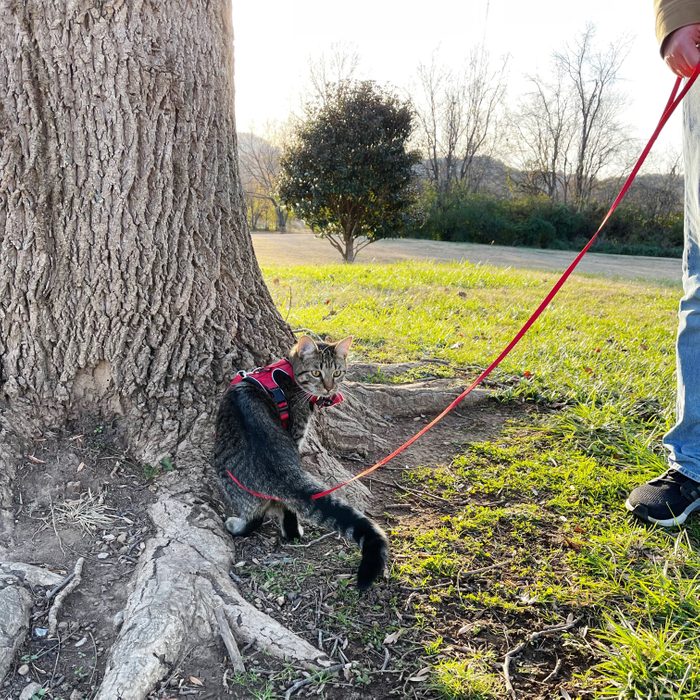
What steps should you take the morning of your flight?
1. Don’t feed your cat
It might seem heartless, but you’ll be doing your cat’s stomach a favor by withholding breakfast before your flight. “Cats with an empty stomach are less likely to vomit,” Dr. Smith says. (If your flight is later in the day, your cat’s last meal should be about six hours before flying.) Keep a snack bag of cat food and treats handy to give on the plane or in case of long delays. And don’t forget to pack a spill-proof bottle, fill it up after security and offer water frequently throughout the trip to avoid dehydration.
2. Keep calm and carry pheromones
Travel days are hectic enough without starting on the wrong paw. Get organized the night before, and avoid frantically looking around for those last-minute items to stash in your suitcase. “Try to stay calm, as cats can pick up on our energy,” Coelho says. “If you’re frazzled, your fur baby will be too.”
Even if you’re cool as a cucumber, your cat may still need a little more help relaxing. Over-the-counter remedies may help settle kitty jitters. Dr. Magnuson suggests Feliway spray to wipe down the insides of the cat carrier or Bach Rescue Remedy essential oil. While these remedies are generally safe, check with your vet first. “If your cat has any underlying disease, I recommend talking with your veterinarian prior to starting any supplements,” Dr. Magnuson says. If you get the OK, try out these remedies in your practice runs before the big trip.
3. Give meds if needed
Prescription anxiety medications can work for cats that may need even a little more help. Vets often prescribe Gabapentin, a drug used for pain and sedation, to ease the stress of traveling. “If your veterinarian does prescribe Gabapentin, it is very important that you try this prior to flying so you know and understand what your cat will look and act like before you are 30,000 feet in the air,” Dr. Magnuson says. Gabapentin causes deep sedation—more than a cat nap—and it can be frightening to see your pet totally zoned out for the first time, so try it at home before flying.
Another common ailment for feline travelers is vomiting. If your cat has thrown up while riding in the car, talk to your vet about prescription drugs, such as Zofran or Cerenia. “These medications work in different ways but make a cat less nauseous,” Dr. Magnuson says. Whether you choose natural supplements or prescription meds, conduct a trial run with them before your trip.
4. Stash comfort items in the cat carrier
Place your feline’s favorite blanket, cat toys and other comfort items in the carrier. “The more items that have their scent on them, the better,” Bell says. Speaking of comfort, your cat may prefer a hands-off approach instead of a snuggle on travel day. Stash a lightweight blanket to drape over the carrier to reduce stimuli during the trip. Also stock the carrier with extra potty pads, a bit of litter and disposable gloves for cleanup.
5. Get to the airport early
Harness your cat and place them in the carrier before you leave home. It’s going to take a bit longer getting through TSA with your pet, and the last thing your cat needs is the stress of a mad dash to the airport, so Coelho recommends arriving early. The general guideline is to be at the airport two hours before a domestic flight, so when you’re traveling with your furry friend, you’ll want to get there at least two-and-a-half hours before.
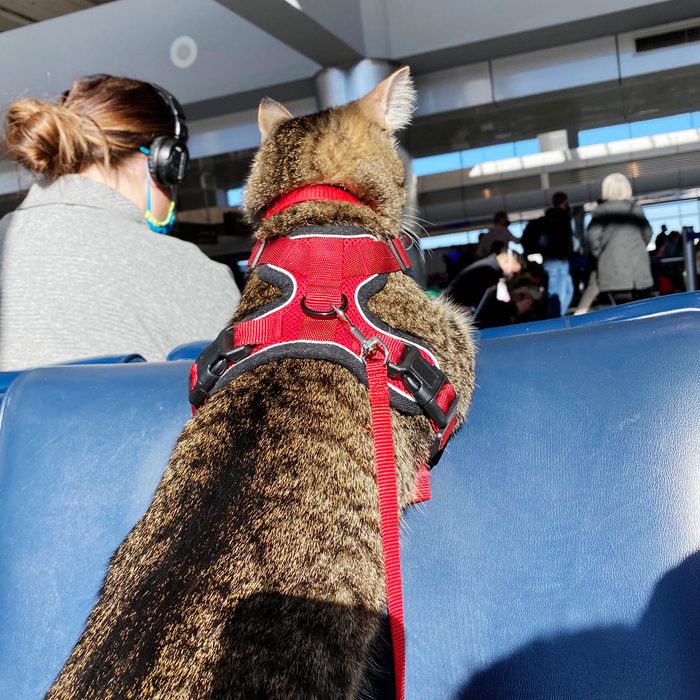
What steps should you take at the airport?
1. Talk to your cat
“I know this sounds odd, but acknowledging and assuring your cat that everything is OK is important,” says Coelho. If your cat is harness-trained, you can let it out of the carrier to sniff around and adjust to the surroundings. If you sense you have an angry cat on your hands that would rather stay hidden in the carrier, that’s OK too. Try putting the carrier on your lap and talking softly to your kitty.
2. Get both the cat and carrier ready for TSA
Although TSA policies are generally universal, each airport has its own procedures and quirks. Here’s how the process generally unfolds: “You will have to take your cat out of the carrier and remove its leash before the carrier goes through the X-ray machine. Then you’ll hold your cat in your arms as you walk through the metal detector,” Bell says. Since nervous cats may flee as soon as the carrier door opens, Bell deliberately leaves the leash on her cat with the end of it sticking out of the carrier. When she opens the carrier, she can get a good grip on the leash and secure her cat in her arms before removing the leash.
Coelho tucks D’Artagnan’s head between her arm and body when walking through security. “The clashing of plastic tubs scares him, so I tuck his head to help calm him down,” she says.
3. Ask for a private TSA screening
If your cat is incredibly anxious in new situations and you’re worried you won’t be able to hold your cat safely, you can ask TSA for a private room for the screening. “While this allows you to keep your cat in an enclosed space, it will take quite a bit of extra time,” Bell says, “so be sure to plan ahead for that.”
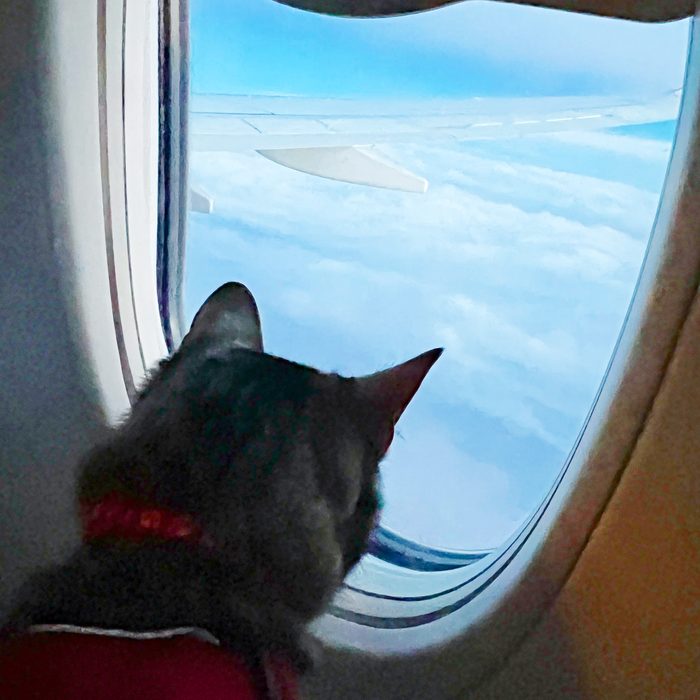
What do cats do on a plane?
Ideally, your cat will chill and nap during the flight. When your cat isn’t happy, it’s natural to want to provide snuggles and comfort, but all airline policies clearly state that cats must stay in their carriers while in the cabin. On one flight, D’Artagnan was loudly expressing his discontent. “It was heartbreaking,” Coelho says. With permission from her seatmate and the flight attendant, she took him out of the carrier. “I pulled him onto my lap, gave him tuna paste and offered him some water. He also got hugs and kisses, and I let him sniff around and look out the window,” she says. But when she tried this approach on another airline, she was asked to put D’Artagnan back in his carrier, so she took the carrier to the airplane bathroom to console him.
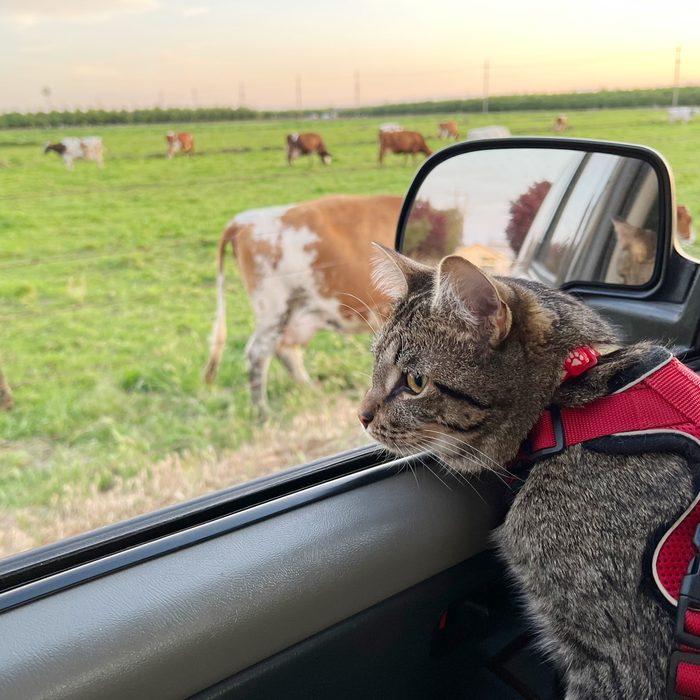
What steps should you take when you arrive?
1. Take a comfort break
Depending on the nature of your cat, you may want to let it out of the carrier after you land, especially if you have to travel in a car for a while to get to your final destination. Find a quiet area where your cat can stretch its legs and sniff if interested. Cats are persnickety about going potty in strange places. If your cat didn’t go while in the carrier on the plane, you could try the airport bathroom. But don’t be surprised if your cat holds it until you reach your final destination.
2. Acclimate to new surroundings
Now that you’ve learned how to fly with a cat successfully, you can finally relax at a pet-friendly hotel or friend’s guest room. Since traveling can be very disruptive to a cat, unpack your kitty’s essentials as soon as possible so it can get back to a sense of normalcy. “The very first thing would be to get the litter tray and food station set up and introduce them to their new place,” says Coelho. Your cat might explore the new space or choose to hide for a bit. Don’t take it personally if your cat is mad at you, and do let it acclimate at its own pace. Eventually, your kitty will eat, go potty and snuggle with you.
About the experts
|
Why trust us
Reader’s Digest has published hundreds of travel stories that help readers explore the world safely, easily and affordably. We regularly cover topics such as the best places to visit (and the best times to visit them), tips and tricks to zoom through airport security, flight-attendant secrets, hotel-room hacks and more. We’re committed to producing high-quality content by writers with expertise and experience in their field in consultation with relevant, qualified experts. We rely on reputable primary sources, including government and professional organizations and academic institutions as well as our writers’ personal experiences where appropriate. For this piece on how to fly with a cat, Lisa Marie Conklin tapped her experience as a cat owner and a longtime journalist who covers pets for Reader’s Digest. We verify all facts and data, back them with credible sourcing and revisit them over time to ensure they remain accurate and up to date. Read more about our team, our contributors and our editorial policies.
Sources:
- Jeff Smith, DVM, veterinarian and owner of Danville Family Vet; email interview, 2022
- Melissa Magnuson, DVM, veterinarian at Canobie Lake Veterinary Hospital; email interview, November 2024
- Samantha Bell, cat expert at Best Friends Animal Society; email interview, 2022
- Elainna Coelho, cat parent of D’Artagnan; email interview, 2022
- American Airlines: “Pets”
- Delta: “Pet Travel on Delta”
- JetBlue: “Traveling with Pets”
- Southwest Airlines: “I want to book travel with my pets”
- United Airlines: “Traveling with Pets”
- U.S. Department of Transportation: “Service Animals”


















